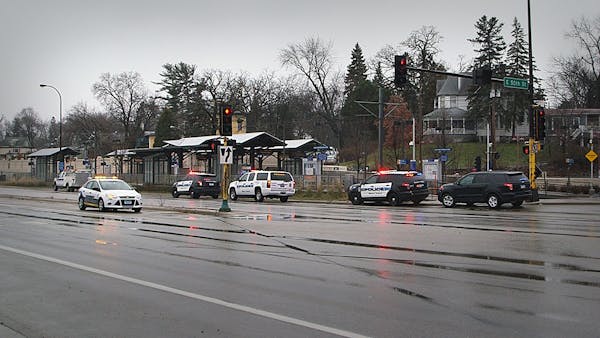It's been a deadly year for Minnesotans on foot.
The combination of distracted drivers rolling through red lights and pedestrians more mindful of their cellphones than crosswalks has helped push the number of pedestrian deaths to 38 as of mid-December.
Hundreds more walkers have been hurt seriously enough on the streets — even in crosswalks — to land in the emergency room. In the past two weeks, three pedestrians have been hit by light-rail trains. One died.
After falling to a six-year low of 17 in 2014, deaths are back in the 35-40 range of previous years, and safety experts are imploring drivers and pedestrians alike to put down their cellphones, headphones and tablets and start paying attention.
For the first time this year, the National Safety Council added cellphone-distracted walking to its data of unintentional deaths and injuries. The council found that between 2000 and 2011 more than 11,000 people were injured while walking and talking on their phones.
The Urban Dictionary even has a new term for these would-be multi-taskers: "petextrian."
That describes Ben Dezell, of Champlin, who was so busy using his phone to find a downtown Minneapolis restaurant that he barely looked up while crossing 6th Street and 2nd Avenue S. Tuesday afternoon. "I was trying to look at both," said Dezell. Asked if he thought that was dangerous, he sheepishly said, "Yeah, a little … I shouldn't be doing it."
While the danger of distracted driving has received lots of attention, new research shows that pedestrians using cellphones, headphones and tablets are increasingly putting themselves in harm's way.
Inattentive walkers take longer to cross the street and are more likely to ignore traffic lights or fail to look both ways. Such risky behavior has caused the percentage of pedestrians killed while using cellphones to rise from less than 1 percent in 2004 to more than 3.5 percent in 2010, according to Ohio State University research cited in a report earlier this year by the Governors Highway Safety Association. The same research also found that injuries among cellphone-using pedestrians jumped from 256 in 2005 to more than 1,500 in 2010.
The rise in pedestrian injuries linked to cellphone distractions parallels the eightfold increase in cellphone use in the past 15 years. For pedestrians, distraction can cause them to trip, cross roads unsafely or walk into street signs, doors or even walls, a National Safety Council report said.
"Cellphone use reduces situational awareness. You are unaware that you are unaware," said Lisa Kons, continuing education coordinator for the Minnesota Safety Council. Peripheral vision drops by 10 percent when you're using a mobile device, she said, enough to miss a traffic light or an oncoming car. "That pulls our attention away and results in unsafe behavior," she said.
Pedestrian deaths in Minnesota ranged between 35 to 41 from 2009 to 2013 before plunging in 2014 and rebounding this year.
Failure to follow the rules of the road was the most commonly cited factor (24 percent) in pedestrian crashes in which the person on foot was found to be at fault, according to the Minnesota Department of Public Safety data. When drivers were at fault, 31 percent failed to yield the right of way and 20 percent were distracted, the data said.
'You can't multi-task'
So far this year, Hennepin County Medical Center has admitted 133 pedestrians due to falls and fractures, with 96 of them hit in a crosswalk.
That's up from 108 last year and 88 in 2011 and does not include the 1,032 pedestrians who were treated for less serious scrapes and immediately released during the same period.
The message is simple, Kons said: "That's eyes looking up and brain in the game.
"You can't multi-task. That is the biggest myth," she said. "We all think we are the best multi-tasker there is. When you are out there, you need to be focused on the task at hand, and that is getting from Point A to Point B safely."
Lesson learned for south Minneapolis resident Eric Weiss. After several close calls, Weiss, 31, said he tries to make eye contact with drivers before crossing the street. And he not only looks both ways, but "I also look behind me."
Mike Mechtenberg, 37, of St. Paul, said he crosses only at intersections and wears a reflective vest when walking at night. Still, he recently came within an eyelash of getting hurt two weeks ago while walking home from church. A motorist stopped to let him and his wife use the crosswalk and was rear-ended by another driver.
Ian Futterer, 22, who commutes on foot to his job in downtown Minneapolis, said he's seen enough to make him a super-cautious pedestrian. At least twice a month he said he has had to jump out of the way in a crosswalk as a motorist sped by. Once he was clipped by a driver's side mirror.
"I do feel it's more dangerous out there," he said. "I put my phone away. I act appropriately. I don't want to be blood on the sidewalk or a statistic."
Tim Harlow • 612-673-7768
Searching for Snoopy: What happened to all the 'Peanuts' statues in St. Paul?
North Oaks withdraws request for density exemption from Met Council

Fall or spring, it's Rochester Mayo's year in prep tennis

Minneapolis reaches $150k settlement with eyewitness of George Floyd's murder

